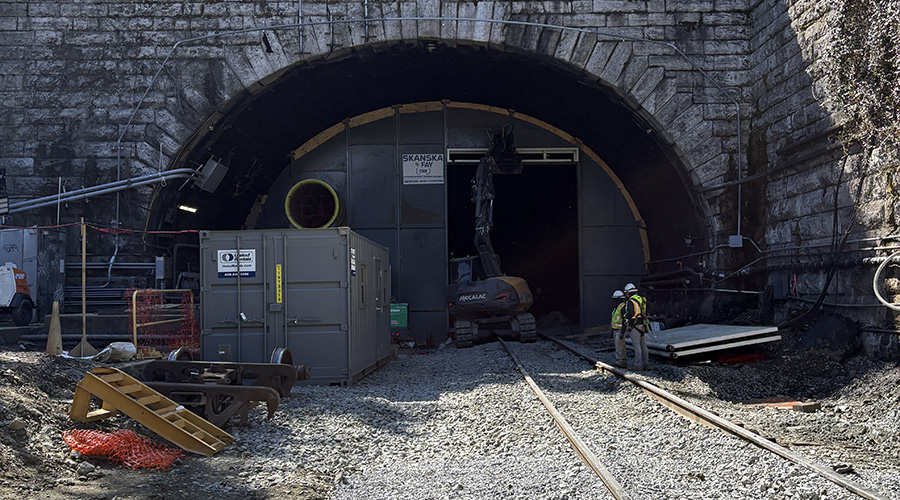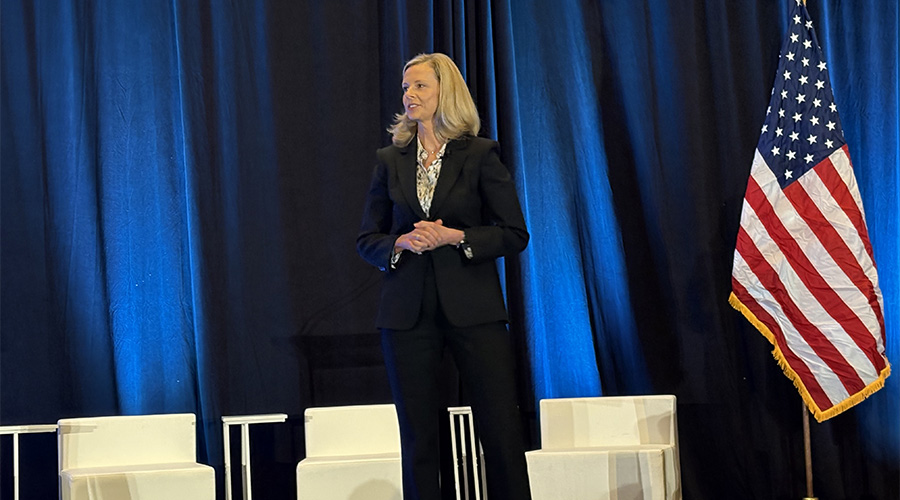STB collects service recovery reports from BNSF, CSX, NS, UP
5/27/2022
By Julie Sneider, Senior Associate Editor
BNSF Railway Co., CSX, Norfolk Southern Railway and Union Pacific Railroad late last week filed their service recovery plans with the Surface Transportation Board, which ordered them to do so on May 6 in response to extensive complaints from rail shippers and stakeholders over the past several months.
In their reports, the Class Is describe specific actions they are taking to improve their service. The railroads also report key performance indicators used to evaluate their progress; rail staffing levels; and plans for fuel conservation.
The STB ordered the four railroads to submit their intentions for improving service after a two-day hearing in April during which dozens of representatives of rail labor unions, customers and shippers testified on the recent service problems. Class I executives acknowledged their railroads have struggled to provide the service they and their customers expect, and blamed several factors, including staffing shortages. Many speakers said they believed the service problems were caused by the railroads’ adoption of precision scheduled railroad operating models and related workforce reductions.
In their responses, the railroads acknowledged that an efficient freight-rail system is vital to the overall supply chain and national economy.
In its service recovery report to the STB, BNSF said a number of factors caused the problems, but they were mainly due to “a sharp increase in volumes in 2021 that was far in excess of what BNSF and our customers had forecasted.” The accelerated demand that occurred in early 2021 outpaced the ability to quickly flex up resources to handle the volume surge, BNSF reported.
BNSF’s recovery plan consists of bringing more crews and locomotives online to match resources to volume; and reducing excess cars on the network to clear congestion and move customers’ freight.
Regarding hiring and training efforts, BNSF reported moving quickly in fourth-quarter 2021 to increase hiring efforts, particularly on the network in areas where it’s harder to hire and retain operating employees. The Class I has an “aggressive” 2022 hiring plan to bring in, train and deploy employees to meet anticipated needs.
In addition, BNSF has recalled all but 23 of its furloughed train, yard and engine (TY&E) employees. The railroad has hired 402 TY&E employees so far in 2022, and 229 newly hired TY&E employees have completed their training. Another 209 will complete their training in the next 90 days.
Accelerating recruitment, retention efforts
To support recruitment, BNSF has stepped up job candidate offers to make up for a lower acceptance rate and higher attrition rate that occurs during training — a situation characteristic of a tight labor market. The railroad is offering incentives such as sign-on bonuses to job candidates or enhanced relocation benefits to current employees willing to locate in high-need areas; and offering payments and other incentives to current employees to take short-term assignments in labor-shortage areas, including the Pacific Northwest.
“Our hiring plans are also affected by the levels of attrition we are experiencing in parts of our network, and we will continue to monitor those trends,” BNSF reported.
BNSF also increased its locomotive fleet. When it initialized its recovery plan in March, the railroad had already taken 250 locomotives out of storage and planned to bring another 100 online.
“We have since accomplished that goal, thus increasing our active locomotive fleet by 350 units since the start of winter,” BNSF’s report states. “We surged resources to our locomotive shops to get these units ready for active service quickly, and we will continue to use that flex capacity at our shops to minimize downtime for maintenance and repair to ensure our fleet remains at the right size for our volumes.”
Managing car inventory is one of the most impactful actions the railroad can take to reduce congestion and improve fluidity and service by making more loadings and delivering them faster, BNSF officials wrote.

As for its key performance indicators, BNSF is tracking the plan’s effectiveness by monitoring train velocity, terminal dwell, average trains holding, on-time performance and local-service compliance. BNSF is charting and reporting data on those indicators biweekly to the STB.
Meanwhile, CSX’s plan addresses service performance indicators that include trip plan compliance, first/last mile, velocity and dwell data. The Class I also explained how it is addressing its labor shortage by being “more creative and determined” in recruiting, staffing and engaging employees.
Increasing training classes, teachers
To meet hiring goals, CSX has modified recruitment initiatives to expand the candidate pipeline for conductor positions and retain applicants and trainees. The railroad reevaluated the job requirements and eliminated unnecessary prerequisites. It also expanded the CSX presence across several types of media; is offering referral bonuses to current employees; worked with SMART-TD to increase trainees’ pay by 40%; and enhanced the applicant and trainee experience.
“For example, the CSX training center now has expanded class sizes that accommodate 40 or more trainees per class and CSX has reduced the burden of expense reimbursement by providing trainees with gift cards,” CSX’s report states.
To help retain current employees, CSX offered incentives such as opportunities to earn prizes for good attendance; offered voluntary temporary transfers to locations in need of more T&E employees; and engaged T&E employees to support work-life balance.
CSX has said it expects to be back to pre-pandemic T&E levels in the third-quarter 2022. As of May 18, CSX had 675 T&E employees who began training in 2022, and 436 who had completed training.
Likewise, NS addresses its efforts to have “the right number of T&E employees at the right location at the right time to meet the demand” — which is essential to the railroad’s service recovery plan. Unlike other railroads, NS’s overall turnover rate for qualified T&E employees has remained steady over the past three years. However, NS experienced significantly higher turnover in certain key locations, the company said in its report.
To bring in more T&E candidates as quickly as possible, NS added resources to its talent acquisition, health services and technical training teams; streamlined the hiring and onboarding process; started new conductor classes every week this year; added shifts at the NS technical training center in McDonough, Georgia; and increased the number of trainers. NS officials expect the T&E headcount to grow sequentially throughout the year. As of May 16, the company had 930 conductor trainees.
NS is also looking for ways to address work/life balance issues for conductors, who typically have unpredictable schedules and sometimes spend time away from home. To retain current employees, the company is offering availability bonuses, retirement deferral incentives and vacation buybacks.
“We have grown the ranks of our ‘go teams’ and reprioritized their deployment to the areas of our network experiencing the most critical need,” the NS report states. “We have also offered seven temporary transfer incentives to help address localized needs for months at a time, as well as permanent transfer incentives.”
At UP, about 150 TE&Y employees to specific hubs in need of additional crew members. Train service hiring and training has been increasing since Q4 2021. As of May 6, 667 employees started and 223 completed training.
Improving fluidity, locomotives, rail-car numbers
Other initiatives mentioned in UP’s service recovery plan:
• Network fluidity: UP has increased and redistributed crews, locomotives and freight cars to reduce congestion and improve fluidity. Those efforts have started to pay off, with performance improving since mid-April. Operating inventory decreased by 11,000 cars; cars per carload decreased from 8.9 to 8.6; and there’s been a 4% to 8% improvement in train velocity and car dwell. Car velocity has risen from 177 miles per day to 189.
• Locomotives: UP added 150 locomotives to the network and is preparing 300 more to return to service in anticipation of growth later this year and early 2023. Gradually adding the 300 units will also enhance the railroad’s ability to respond to network disruptions.
• Freight cars: UP is working to reduce 8% to 10% of the system-owned rail-car fleet in order to reduce congestion and create more train velocity. UP is working with private car shippers to remove 1% to 3% of private cars from the system.
“Union Pacific anticipates that our key performance indicator metrics will recover to levels achieved earlier in the year, which will enable us to move our customers' freight more reliably and consistently,” UP officials wrote to the STB.
Although the four Class Is submitted their recovery reports to the STB, some asked the board to consider points recently made by the Association of American Railroads in May 18 filing with the board. The AAR noted indicated it has some legal issues with the board’s May 6 decision to require the Class Is to submit additional data and reporting requirements in response to the industry’s service problems.
On behalf of the railroads, the AAR questioned whether certain data the board is ordering to be produced now — on an expedited and temporary basis without notice, comment or other rulemaking procedures — is relevant, reliable, appropriate and within the board’s authority to order permanently.
While the Class Is “appreciate the urgency of service problems being experienced by many customers and respect the board’s efforts to respond and assist,” there is no one “quick fix” to what is a complex issue, AAR officials said in the filing.


